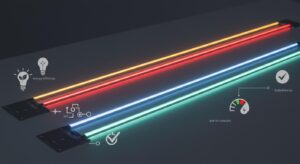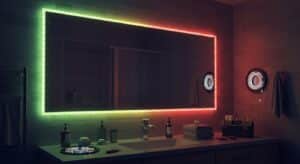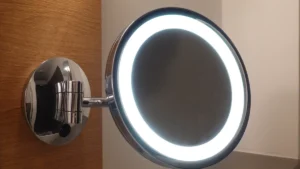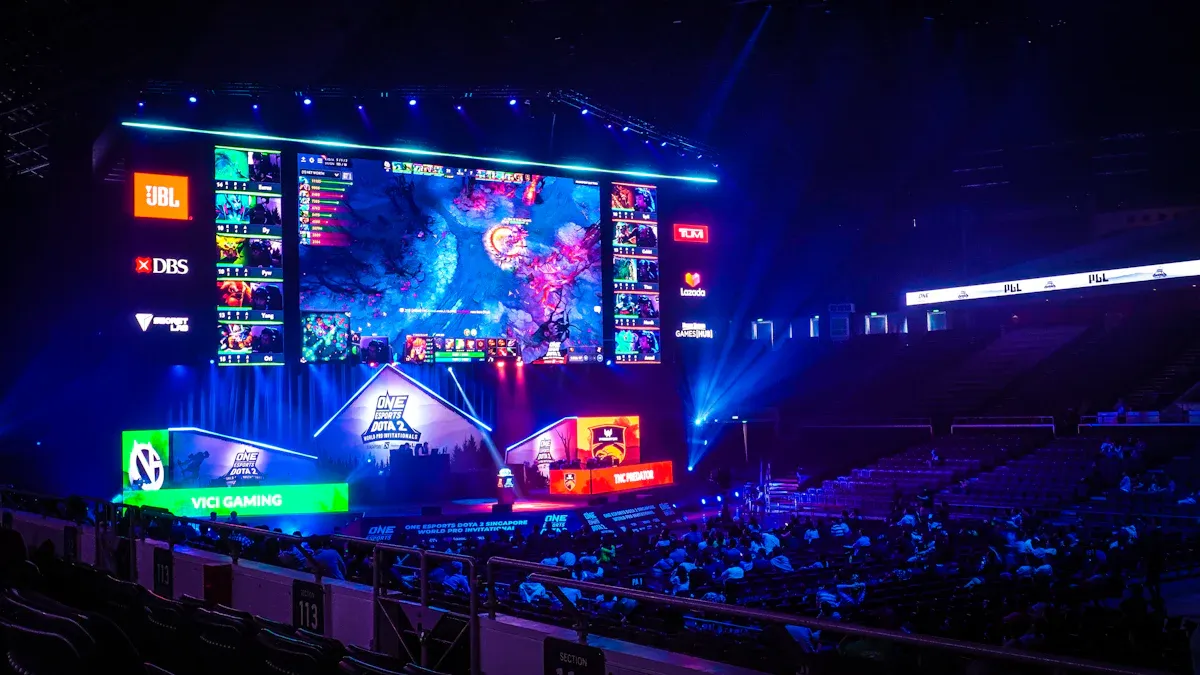
When buying a new TV, you might ask how a LED module TV compares to OLED and QLED screens. Each type has special features. Knowing their differences helps you choose well. How you watch TV, your room size, and your money matter a lot. Understanding these things helps you pick a TV that works well and is worth the price.
Key Takeaways
LED TVs last long and save energy, making them cheap to use daily.
OLED TVs show amazing pictures with deep blacks and bright colors, great for home theaters.
QLED TVs have bright pictures and clear colors, good for sunny rooms or watching sports.
Think about your room: use OLED in dark spaces, QLED in bright ones, and LED TVs for regular use.
Money counts: LED TVs cost the least, OLEDs cost the most but look the best.
Understanding LED Module TVs, OLED TVs, and QLED Displays
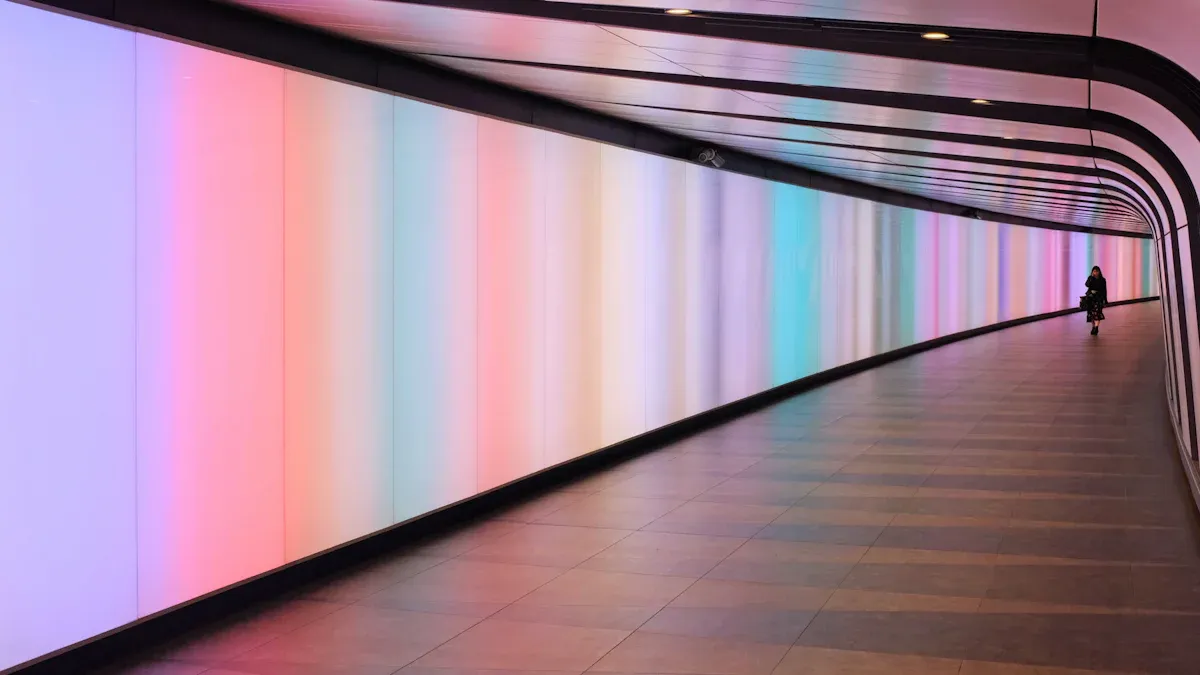
What Are LED Module TVs?
LED module TVs use special LED lights for bright pictures. These TVs have many small LED parts that work separately. This design helps control brightness and contrast better. Unlike older LED TVs with one backlight, these TVs adjust each part for clearer images. They are great for big screens in homes or public places.
One big benefit of LED module TVs is their toughness. If one part breaks, it can be fixed without replacing the whole TV. This makes them cheaper to maintain and last longer. They also save energy, using less power than older LCD or plasma TVs. If you want a strong and flexible TV, an LED module TV is a good pick.
What Is an OLED Display?
OLED TVs are a big step forward in screen technology. Unlike LED TVs, OLED screens light up each pixel on their own. When a pixel is off, it shows true black, giving amazing contrast. This makes OLED TVs perfect for home theaters with deep blacks and bright colors.
New OLED tech has made these TVs even better. Tools now check brightness and make sure the screen looks even. A process called demura fixes flaws, so OLED TVs look great and are easier to make. These updates make OLED TVs stunning and more efficient.
But OLED TVs have downsides. They cost more and may not last as long because of their materials. Still, if you care about picture quality and color, OLED TVs are a top choice.
What Are QLED TVs?
QLED TVs mix LED and quantum dot tech for great pictures. QLED stands for Quantum Dot Light Emitting Diode. These TVs use quantum dots to make colors brighter and sharper. Unlike OLED TVs, QLED TVs need a backlight, like older LED TVs. But quantum dots make them perform much better.
New QLED features include quantum dot layers that improve brightness and colors. Some QLED TVs also use MiniLED lights for better contrast. But sometimes, bright spots can spill into dark areas, which affects the picture.
Samsung’s QD-OLED screens, shown in 2022, combine QLED and OLED tech. These screens have better colors and brightness than regular OLED or LCD TVs. If you want bright colors and sharp images, a QLED TV is a great option.
LED vs OLED vs QLED: Comparing Key Features
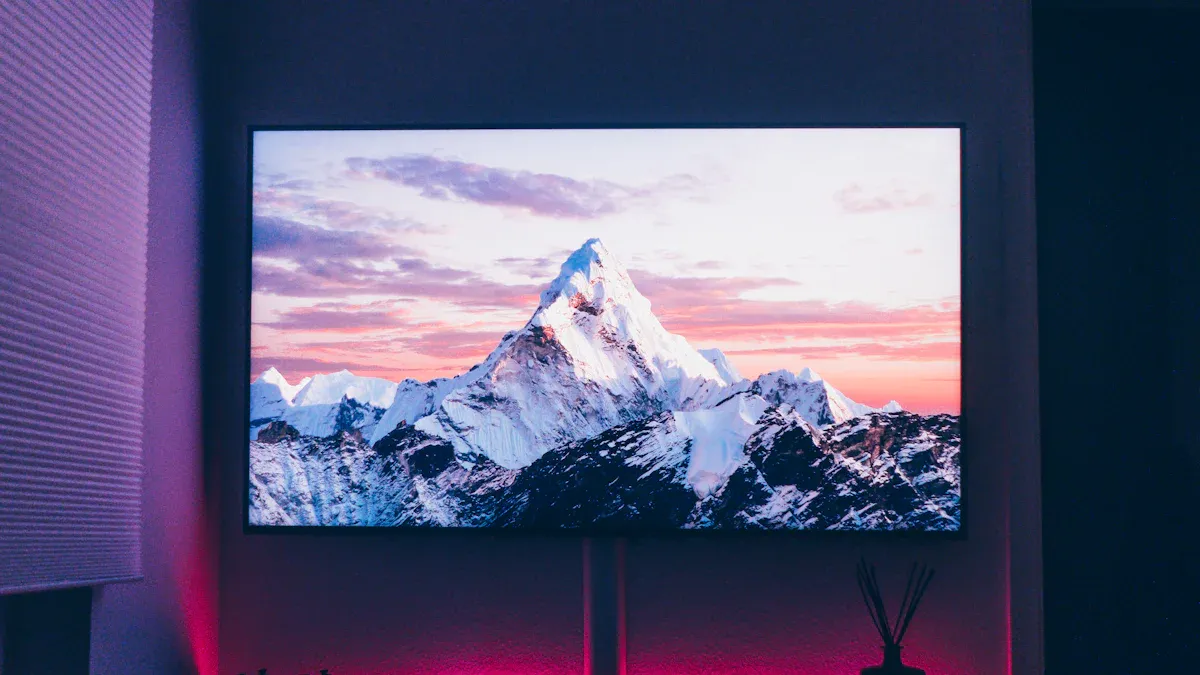
Image Quality and Color Accuracy
The picture quality of LED module TVs, OLED TVs, and QLED displays is different. Each type has its own strengths in showing colors. OLED TVs are great for bright colors and true blacks. They use pixels that turn off completely, making the contrast amazing. QLED displays use quantum dots to show bright and accurate colors. These are best for rooms with lots of light. LED module TVs are not as advanced but still show good colors. New tech like Mini LED backlights makes them even better.
Tip: Want deep blacks and great color? Pick OLED TVs. For bright rooms, QLED displays are a better choice.
Here’s how color accuracy compares across display types:
Display Type | Color Accuracy (sRGB) |
|---|---|
AMOLED | 100% |
QD-OLED | 98% – 100% |
OLED | Below QD-OLED |
Mini LED | 97% – 100% |
QLED | 95% or higher |
Brightness and Contrast Performance
Brightness and contrast decide how TVs look in different lighting. QLED displays are very bright, perfect for sunny rooms. They keep colors strong even at high brightness. But they can’t show true black because of light leaks, which lowers contrast. OLED TVs are best in dark rooms. They turn off pixels to show true black, giving amazing contrast. LED module TVs with Mini LED tech are in the middle. They are brighter and have better contrast than older LED TVs but not as good as OLED TVs.
Technology | Brightness Performance | Contrast Performance |
|---|---|---|
QLED | Very bright; great for sunny rooms. | Can’t show true black; good but not perfect contrast. |
OLED | Less bright; best for dark rooms. | Shows true black; amazing contrast. |
QLED: Best for bright rooms with vivid colors.
OLED: Perfect for dark rooms with deep blacks.
Energy Efficiency and Power Consumption
Energy use is important when picking a TV. LED module TVs save the most energy, meeting EU rules of 85 lumens per watt. They are cheap to run long-term. OLED TVs use more power but save 30% more energy than QLED displays. QLED TVs are the least energy-efficient because of their high brightness, which costs more to run.
Technology | Energy Efficiency Rating | Operational Cost Comparison |
|---|---|---|
LED | Minimum 85 lumens per watt (EU Directive) | N/A |
OLED | 30% lower than QLED | N/A |
QLED | Higher operational costs compared to OLED | N/A |
Note: For saving energy, LED module TVs are the best. OLED TVs balance power use and quality. QLED displays are for those who want brightness over savings.
Durability and Lifespan
When picking a TV, how long it lasts matters. You need a TV that works well for years. LED module TVs, OLED displays, and QLED TVs each have pros and cons in this area.
LED module TVs are strong and built to last. They use parts you can replace if they break. This makes fixing them cheaper. But not all LED TVs are the same. A test by RTINGS.com showed edge-lit LCD TVs often have problems like warped parts or burnt-out lights from heat. Full-array local dimming (FALD) and direct-lit LED TVs are better. Only 20% of these had issues, compared to 64% of edge-lit models. This shows heat control is key for LED TVs.
OLED TVs look amazing but don’t last as long. Their organic materials wear out over time, making them less durable. Burn-in is another issue. Watching channels with logos or playing games with fixed images can leave marks on the screen. Newer OLED TVs have tools like pixel-shifting to help prevent burn-in, making them more reliable than older ones.
QLED TVs balance durability and performance well. They don’t get burn-in like OLEDs. Their quantum dots are stable and last longer. But edge-lit QLED TVs can have problems like edge-lit LCD TVs. Choosing models with MiniLED or FALD backlighting improves durability and gives better brightness and contrast.
Tip: For a long-lasting TV, pick LED module TVs with FALD or direct-lit designs. If you want top image quality and can handle burn-in risks, go for OLED TVs. For a mix of durability and performance, choose QLED TVs with advanced backlighting.
Cost and Affordability
Your budget is important when buying a TV. The prices of LED module TVs, OLED displays, and QLED TVs vary based on features and tech.
LED module TVs are the cheapest option. They perform well and cost less, making them great for saving money. Their design also lowers repair costs since you can replace parts instead of the whole TV.
OLED TVs are more expensive. Their advanced tech and amazing picture quality come at a high price. A 4K OLED TV starts at $1,600 and can go up to $13,000. While they offer the best contrast and colors, their price may not suit everyone.
QLED TVs are priced between LED module TVs and OLED displays. A 4K QLED TV costs $800 to $6,500, while 8K models range from $5,000 to $15,000. These TVs give bright colors and sharp images, making them a good choice for those who want quality without spending as much as on OLEDs.
Technology | Price Range (4K Sets) | Price Range (8K Sets) |
|---|---|---|
LED Module TVs | $300 – $2,000 | N/A |
QLED | $800 – $6,500 | $5,000 – $15,000 |
OLED | $1,600 – $13,000 | N/A |
Note: For a low-cost option with good performance, pick LED module TVs. For the best picture quality, OLED TVs are worth it. If you want both quality and value, QLED TVs are a smart choice.
Practical Recommendations Based on Use Cases
Best Display Technology for Home Theater
For a home theater, you need amazing picture quality. OLED TVs are the best choice because they show true blacks. They also have great contrast, making them perfect for dark rooms. This creates a cinema-like experience at home. Their pixels light up individually, making scenes look real and colorful.
To get the best results, proper setup is important. Groups like SMPTE set rules for adjusting colors, brightness, and contrast. Without these settings, even good TVs may not look their best.
Here’s a simple comparison of displays for home theaters:
Display Type | Key Features | Things to Consider |
|---|---|---|
Self-contained Displays | Light up on their own; include TVs and monitors. | Size, resolution, brightness, and contrast matter most. |
Front Projection Displays | Use a projector and screen; show bigger images. | Need dark rooms for best performance. |
Tip: Want a bigger screen? Try front projection displays. For most homes, OLED TVs are the easiest and best option.
Best Display Technology for Gaming
Gamers need smooth gameplay with fast response times. OLED TVs are great for this, with low input lag and fast refresh rates. They can go as low as 10ms lag and up to 120Hz refresh rates. This makes them perfect for serious gamers. New LED TVs with Mini LED tech also work well and cost less.
Here’s how refresh rates and input lag compare:
Refresh Rate | Minimum Input Lag |
|---|---|
60Hz | 8.33 ms |
120Hz | 4.17 ms |
144Hz | 3.47 ms |
165Hz | 3.03 ms |
240Hz | 2.09 ms |
360Hz | 1.39 ms |

Note: For competitive gaming, pick displays with high refresh rates and low input lag. OLED TVs or gaming monitors are great options.
Best Display Technology for Professional Use
Professionals like designers or photographers need accurate colors and sharp images. OLED TVs and QLED displays are great for this. OLED TVs show deep blacks and lifelike colors. QLED displays are bright and show clear colors, even in bright rooms.
For offices, LED module TVs are strong and affordable. They work well for presentations or teamwork. Their design makes fixing them easy, saving time and money.
Tip: Use OLED TVs for creative jobs needing perfect colors. For office tasks, LED module TVs are a smart and budget-friendly choice.
Best Display Technology for General Viewing
Picking a TV for daily use needs a good mix of features. Whether you watch sports, news, or shows, the right TV matters.
LED module TVs are a smart and affordable choice. They give clear pictures and last a long time. These TVs also save energy, making them great for everyday use. If you want a dependable TV, this is a good pick.
OLED TVs show amazing colors and deep blacks. They are great for movies or high-quality videos. But they cost more and might not suit tight budgets.
QLED TVs are bright and sharp, perfect for sunny rooms. They handle fast action well, which is great for sports lovers. Though pricier than LED module TVs, they offer excellent quality for general viewing.
Here’s a simple comparison to guide you:
Display Type | Best For | Considerations |
|---|---|---|
LED Module TVs | Everyday use, low cost | Fewer features, less advanced |
OLED TVs | Movies, HD content | Expensive, shorter lifespan |
QLED TVs | Bright rooms, sports | Mid-range price, vivid visuals |
Tip: For a budget-friendly TV, choose LED module TVs. For better visuals, pick QLED or OLED TVs based on your needs.
Picking the best TV depends on what you need. LED module TVs are strong, save energy, and cost less. They are great for daily use or offices. OLED TVs have amazing picture quality with deep blacks and bright colors. They are perfect for home theaters or creative work. QLED TVs are very bright and show sharp images. They work well in sunny rooms or for watching sports.
Here’s a simple feature comparison:
Feature | LED Module TV | OLED | QLED |
|---|---|---|---|
Brightness | Average | Lower | Very high |
Contrast | Decent | Outstanding | Decent |
Durability | Very strong | Medium | Very strong |
Cost | Low | High | Medium |
If you want a low-cost, durable TV, pick LED module TVs. For the best picture quality, choose OLED TVs. If you need bright screens and vivid colors, go with QLED TVs.
FAQ
1. How are LED module TVs, OLED TVs, and QLED displays different?
LED module TVs are strong and save energy. OLED TVs show true blacks and amazing colors. QLED displays are super bright and great for sunny rooms. Each type fits different needs based on where and how you watch.
2. Do OLED TVs have burn-in problems?
Yes, OLED TVs can get burn-in if the same image stays too long. But newer OLED TVs have tools like pixel-shifting to help stop this. You can avoid burn-in by changing what you watch and using screen protection features.
3. What kind of TV is best for gaming?
OLED TVs are great for gaming because they are fast and smooth. They have low lag and bright colors. LED module TVs with Mini LED tech also work well and cost less, making them a good budget pick.
4. Are QLED TVs good at saving energy?
No, QLED TVs use more power than OLED and LED module TVs because they are very bright. If you want to save energy, LED module TVs are the best. OLED TVs use less power than QLED but still give great performance.
5. Can you fix LED module TVs easily?
Yes, LED module TVs are easy to fix. If one part breaks, you can replace it without buying a new TV. This makes them cheaper to repair and last longer, which is great for long-term use.
See Also
Improving Sign Board Illumination With LED Modules
Comparing Edge-lit And Backlit LED Lights For Displays
A Comprehensive Comparison Of SMD 2835, 5050, And 3528 LED Strips
The Advantages Of Using LED Modules For Signage
Understanding COB LED Strips And Their Functionality
